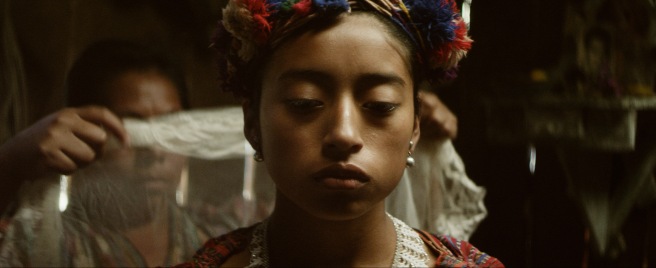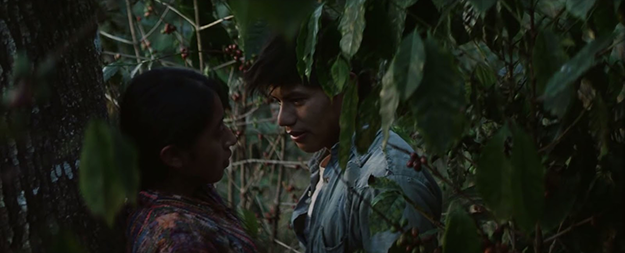
(This review was originally published in 2015 as a part of the Vancouver Film Festival coverage.)
Ixacanul opens on a young woman’s passive form and impassive face. Her name is Maria (María Mercedes Coroy), and her mother (María Telón) dresses her and then smooths, parts, and plaits her hair, securing a crown-like garland upon her head. The two Mayan women, alone together in their home, near a volcano, an ixcanul, in a remote region of Guatemala, both absorbed and silent in the exclusive intimacy of their shared activity, indicate that they inhabit a world with which they are familiar, and I am not. I guess, as I first look at them, that Maria is not quite happy to be so taken in hand by her mother – or perhaps she is not quite happy with the event, unknown as yet to me, for which she is being prepared.
The film could be described as a coming of age tale: Maria has arrived at a marriageable age, and while her parents, hard-working but poor villagers, eagerly seek the best match for her, she herself, in the mini-rebellion many coming of age tales feature, looks, instead, at the young man she prefers and grapples with newly awakened sexual feelings that she’d prefer to explore on her own, rather than within her parents’ control. Maria’s story explores the boundaries of her individual desires, of her parents’ control. Maria grows up over the course of the film, and she is a new person as it closes. And all the pains of her growing up make little fissures in my heart.

But the film could also be described as a socio-political tale: the residents of Maria’s village live under the shadow of a coffee plantation, the white owner, never seen, except perhaps in iconic form, haunts the workers; distinct classes form within the plantation system, those closest to the master with most power, those farthest from him with least. The comparatively wealthy plantation manager alone owns a vehicle, and he holds all the power of livelihood for each family in the village.
Squirming under the class system, many in the village dream of America and spin tales of the strange place, big with promise, that they have not seen, but warn one another of how terribly they will be treated by the “white people,” should they go there. And in the course of the film, two from the village are, we might say, swallowed whole by that incomprehensible larger, more powerful world, and are never seen again. The little village, speaking only the Mayan language, cannot engage, even when pressed by desperate circumstances, in the tactics and language of those with more wealth and power. They agree to what they do not comprehend and are shattered. And I choke and seethe at the injustice played out before me.
And yet, powerful as the coming of age story or the political tale might be, the heart of the film is with Maria and her mother, and the little domestic space they occupy, the close – if sometimes fraught – relationship they share. Maria’s maturation, the politics of the world take on resonance only because we are so thoroughly invested in the connection between these two women. We live with them through their daily chores, in the activities of farm life, of cooking and of baking, of devotion to their volcano god.

In one scene, Maria and her mother set up a mating between their pigs. “Come on; let’s get her pregnant,” says the mother to her daughter, and the women, working quietly with the squealing pigs, expertly ply the rum to the pigs’ eager mouths – and the job is done. In another scene, the women visit a steaming volcanic spot of earth, and the prayers of the mother for her daughter, “Earth, wind, fire, volcano,” she recites, are evidence of another intimate routine. And then, in the night, the firelight of an open fire flickers over the faces of Maria and her mother, as they stir and stir a boiling vat. “Don’t stop; it will burn,” the mother chides, and Maria obediently moves more quickly. Daytime, and the women walk together, bundles of sticks casually balanced on their heads, moving easily through the landscape, gray volcanic rock, blond grass.
Through all these tasks, so obviously familiar to them both, the two work in easy intimacy. Maria, we understand, is under the pressures of individual desires and shy quests for freedom, but always returns to her mother’s side, her mother’s protection. Cooking, bearing wood, bathing, butchering – all these things the women do together – and when Maria’s life reaches a crisis point, it is to her mother she turns, and it is the mother whose strong arms competently, passionately cradle her.
The film ends with the same shot, the same moment with which it began, Maria and her mother and the plaiting and crowning of the hair, but the scene has expanded and deepened. They reside within a relationship of long-standing patterns and behaviors, knowing one another and being known, a small circle of closeness into which I can now see. I understand the activity of the women, I understand something of what is on Maria’s face. I understand what she is to her mother and what her mother is to her, and when the pulling fingers catch for a moment on a snag of hair and then slide free, my own breath catches in a snarl of emotion.
It is the small gestures that cinema, perhaps like no other art, has the power to fill with meaning, and the gestures here, embedded in the small and domestic, ripple outward in waves of resonance.
Ixcanul opens at the Grand Illusion cinema on November 18.
